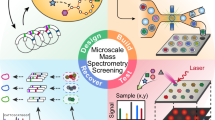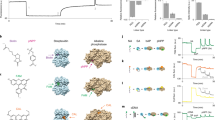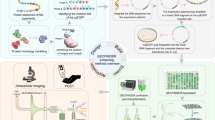Abstract
We introduce a new economic, convenient and general assay principle based on the reversible interaction of water-soluble macrocycles and fluorescent dyes. We show that amino acid decarboxylase activity can be continuously monitored by measuring changes in fluorescence, which result from the competition of the enzymatic product and the dye for forming a complex with a cucurbituril or calixarene macrocycle. The new assay provides a complementary method to the use of antibodies, radioactive markers and labeled substrates.
This is a preview of subscription content, access via your institution
Access options
Subscribe to this journal
Receive 12 print issues and online access
$259.00 per year
only $21.58 per issue
Buy this article
- Purchase on Springer Link
- Instant access to full article PDF
Prices may be subject to local taxes which are calculated during checkout



Similar content being viewed by others
References
Sordé, N., Das, G. & Matile, S. Enzyme screening with synthetic multifunctional pores: focus on biopolymers. Proc. Natl. Acad. Sci. USA 100, 11964–11969 (2003).
Goddard, J.P. & Reymond, J.-L. Enzyme assays for high-throughput screening. Curr. Opin. Biotechnol. 15, 314–322 (2004).
Tawfik, D.S., Green, B.S., Chap, R., Sela, M. & Eshhar, Z. CatELISA—a facile general route to catalytic antibodies. Proc. Natl. Acad. Sci. USA 90, 373–377 (1993).
Koh, K.N., Araki, K., Ikeda, A., Otsuka, H. & Shinkai, S. Reinvestigation of calixarene-based artificial-signaling acetylcholine receptors useful in neutral aqueous (water/methanol) solution. J. Am. Chem. Soc. 118, 755–758 (1996).
Wiskur, S.L., Ait-Haddou, H., Lavigne, J.J. & Anslyn, E.V. Teaching old indicators new tricks. Acc. Chem. Res. 34, 963–972 (2001).
Zhang, T. & Anslyn, E.V. Using an indicator displacement assay to monitor glucose oxidase activity in blood serum. Org. Lett. 9, 1627–1629 (2007).
Bakirci, H., Koner, A.L., Dickman, M.H., Kortz, U. & Nau, W.M. Dynamically self-assembling metalloenzyme models based on calixarenes. Angew. Chem. Int. Ed. 45, 7400–7404 (2006).
Gerner, E.W. & Meyskens, F.L. Polyamines and cancer: old molecules, new understanding. Nat. Rev. Cancer 4, 781–792 (2004).
Blethen, S.L., Boeker, E.A. & Snell, E.E. Arginine decarboxylase from Escherichia coli. J. Biol. Chem. 243, 1671–1677 (1968).
Soda, K. & Moriguchi, M. Crystalline lysine decarboxylase. Biochem. Biophys. Res. Commun. 34, 34–39 (1969).
Tanase, S., Guirard, B.M. & Snell, E.E. Purification and properties of a pyridoxal 5′-phosphate-dependent histidine decarboxylase from Morganella morganii AM-15. J. Biol. Chem. 260, 6738–6746 (1985).
Phan, A.P.H., Ngo, T.T. & Lenhoff, H.M. Spectrophotometric assay for lysine decarboxylase. Anal. Biochem. 120, 193–197 (1982).
Lee, J.W., Samal, S., Selvapalam, N., Kim, H.-J. & Kim, K. Cucurbituril homologues and derivatives: new opportunities in supramolecular chemistry. Acc. Chem. Res. 36, 621–630 (2003).
Koner, A.L. & Nau, W.M. Cucurbituril encapsulation of fluorescent dyes. Supramol. Chem. 19, 55–66 (2007).
Torres, F.E. et al. Enthalpy arrays. Proc. Natl. Acad. Sci. USA 101, 9517–9522 (2004).
Geymayer, P., Bahr, N. & Reymond, J.-L. A general fluorogenic assay for catalysis using antibody sensors. Chem. Eur. J. 5, 1006–1012 (1999).
Das, G. & Matile, S. Substrate-independent transduction of chromophore-free organic and biomolecular transformations into color. Chem. Eur. J. 12, 2936–2944 (2006).
Acknowledgements
We thank J.-L. Reymond, S. Matile and H.-J. Schneider for valuable comments, and acknowledge financial support within the graduate program “Nanomolecular Science” at Jacobs University and by the Fonds der Chemischen Industrie, Frankfurt/Main.
Author information
Authors and Affiliations
Corresponding author
Ethics declarations
Competing interests
The authors declare no competing financial interests.
Supplementary information
Supplementary Text and Figures
Supplementary Figures 1–3, Supplementary Methods (PDF 1368 kb)
Rights and permissions
About this article
Cite this article
Hennig, A., Bakirci, H. & Nau, W. Label-free continuous enzyme assays with macrocycle-fluorescent dye complexes. Nat Methods 4, 629–632 (2007). https://doi.org/10.1038/nmeth1064
Received:
Accepted:
Published:
Issue Date:
DOI: https://doi.org/10.1038/nmeth1064
This article is cited by
-
A supramolecular cucurbit[8]uril-based rotaxane chemosensor for the optical tryptophan detection in human serum and urine
Nature Communications (2023)
-
Cucurbituril curiosities
Nature Chemistry (2023)
-
Host-guest liquid gating mechanism with specific recognition interface behavior for universal quantitative chemical detection
Nature Communications (2022)
-
Versatile non-luminescent color palette based on guest exchange dynamics in paramagnetic cavitands
Nature Communications (2021)
-
Selective discrimination and classification of G-quadruplex structures with a host–guest sensing array
Nature Chemistry (2021)



